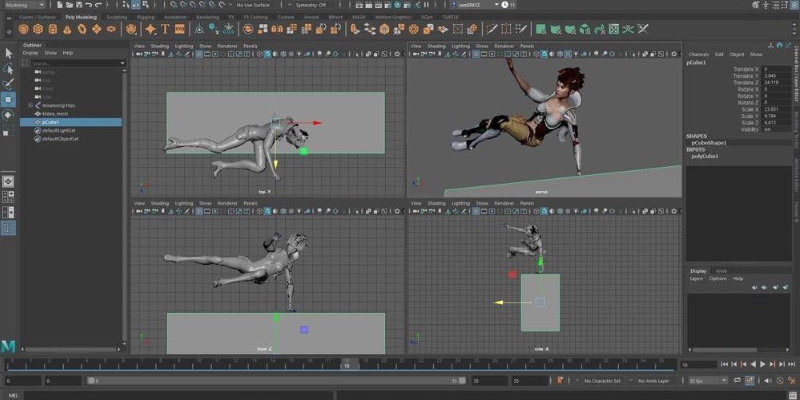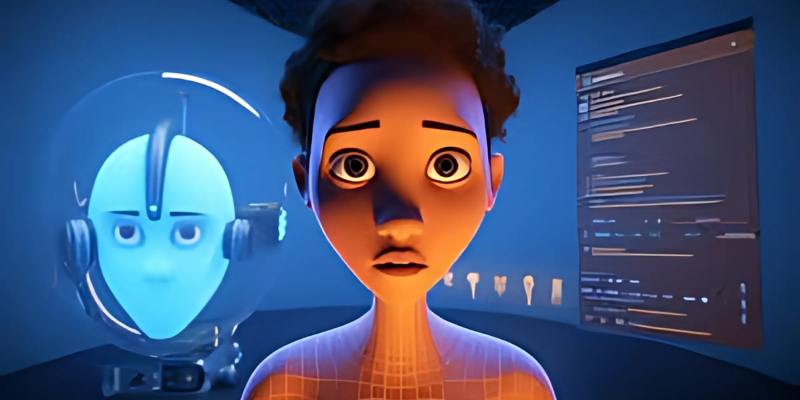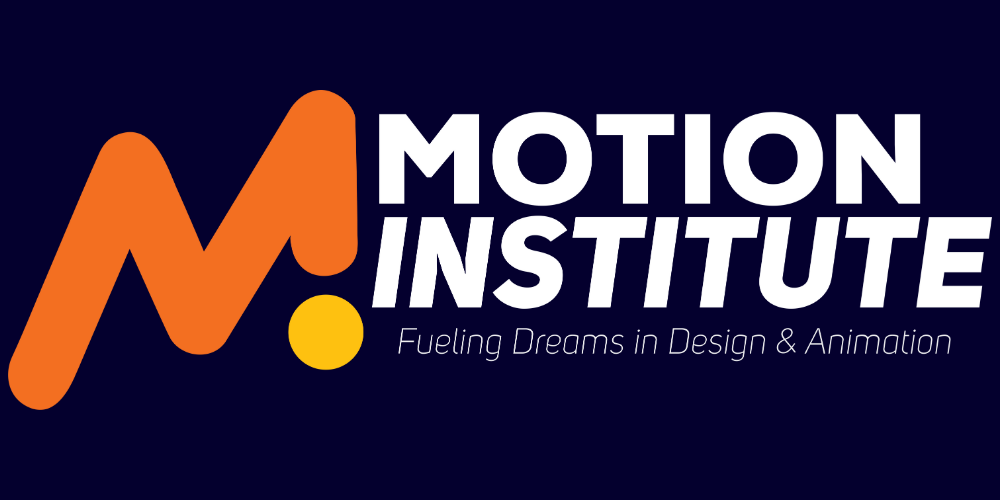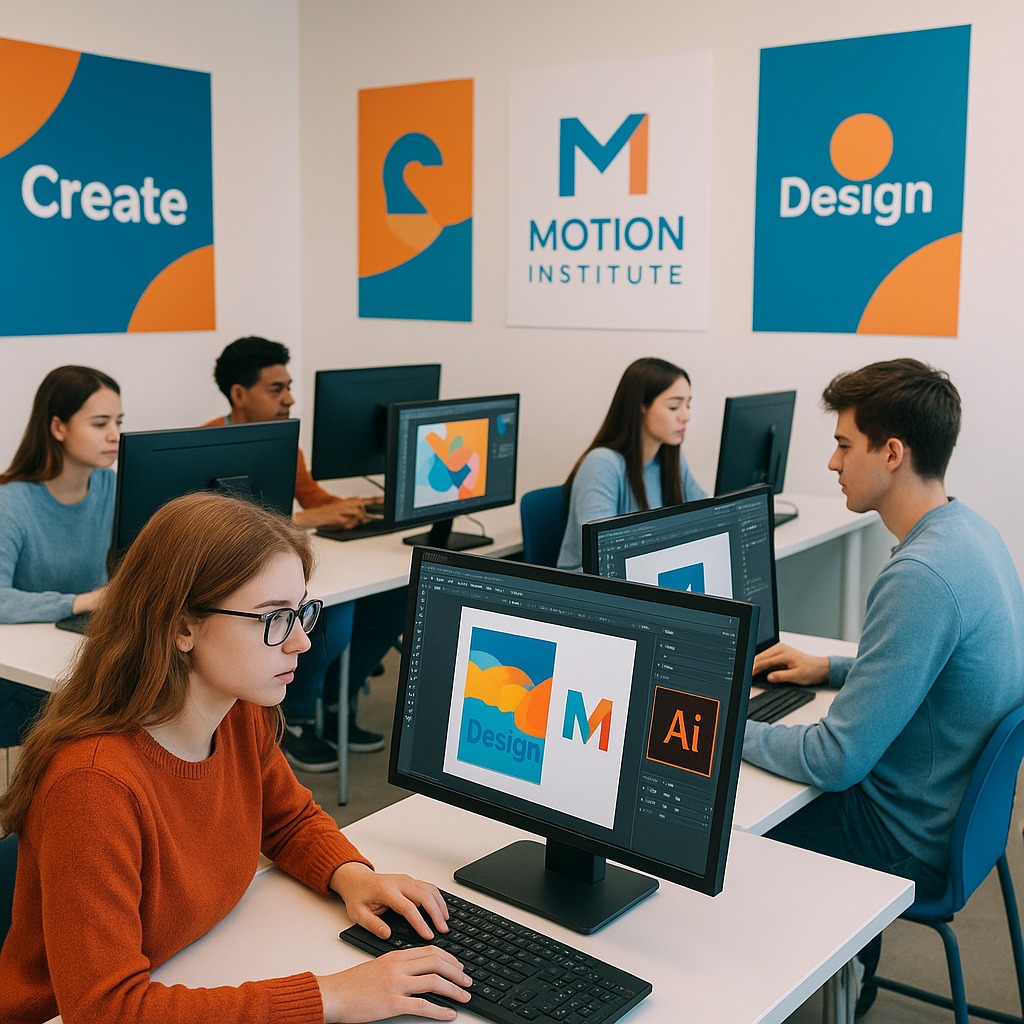Have you ever been completely spellbound by the stunning 3D worlds brought to life in a major film release? Or lost track of time exploring hyper-realistic environments in your favorite video game? Maybe you’ve seen a stunning architectural walkthrough that made you feel like you were already inside a building that doesn’t even exist yet. That’s the magic of 3D animation! It’s an art form that has transcended mere cartoons to become the backbone of modern visual storytelling across countless industries.
Table of Contents
ToggleIf you’re in Kotdwara and dream of shaping these incredible visual futures with your own hands, you might be wondering: “Where do I start?” Finding the best 3D animation course in Kotdwara can feel like a quest, especially with so much rapid evolution in the industry, including the fascinating rise of AI in animation.
Well, good news! This in-depth guide has been crafted especially for your needs. We’re going to demystify the world of 3D animation, explore the powerful software and cutting-edge AI tools for 3D animation you need to master, chart out the diverse and exciting 3D animation career path in 2025, and show you exactly why Motion Institute in Kotdwara is your ideal launchpad for a thriving creative journey.
Your journey to shaping new realities begins now – let’s craft your career, one digital building block at a time!
Why 3D Animation is the Future of Visual Storytelling
Gone are the days when animation was primarily associated with Saturday morning cartoons. While hand-drawn animation still holds its charm, 3D animation has rapidly become the dominant force, pushing the boundaries of realism and immersion. It’s a technological marvel that breathes life into digital assets, making the impossible, visually tangible.
The impact of 3D animation today is truly global and pervasive:
- Film & Television: Think of the breathtaking visual effects in Hollywood blockbusters like “Avatar” or “Dune,” where entire worlds and creatures are brought to life with stunning realism. Or consider the fully animated 3D features from Pixar and DreamWorks that continue to charm audiences worldwide. Even live-action series and OTT content heavily rely on CGI and 3D modeling.
- Gaming Industry: This is where 3D animation truly shines! From the breathtaking open worlds of upcoming titles like Monster Hunter Wilds and Assassin’s Creed Shadows, to the incredibly detailed character designs found in Baldur’s Gate 3 or Final Fantasy VII Rebirth, 3D animators are the architects behind every character, environment, prop, and fluid motion that makes these digital universes so captivating.
- Virtual & Augmented Reality (VR/AR) & The Metaverse: As we step into more immersive digital spaces, 3D animation is foundational. Whether it’s building virtual concert venues, creating realistic avatars, or designing interactive AR experiences for your smartphone, 3D artists are at the forefront of this digital frontier.
- Product Visualization & Advertising: Before a new car is manufactured or a complex gadget is mass-produced, 3D animators create photorealistic renders and animated commercials that showcase every detail, bringing products to life for consumers.
- Architecture & Interior Design: Imagine taking a virtual walkthrough of your dream home before it’s even built! 3D visualization allows architects and interior designers to create stunning, interactive tours and renderings, helping clients truly experience a space.
- Medical & Scientific Visualization: Complex medical procedures, anatomical structures, and scientific phenomena can be animated in 3D for educational purposes, surgical planning, and research, making intricate concepts easy to understand.
For aspiring artists in Kotdwara, this means incredible potential. The demand for skilled 3D animators is booming, not just in metropolitan cities, but across India and globally. With the rise of remote work, your skills mastered right here in Kotdwara can open doors to international projects and renowned studios.
What Makes a 3D Animation Course "The Best" in 2025?
In a fast-evolving field like 3D animation, simply learning software isn’t enough. To truly prepare you for a thriving career in 2025, the best 3D animation course needs to go beyond the basics. Here’s what to look for:
- Industry-Relevant & Future-Proof Curriculum:
- Hands-on, Project-Based Learning: The best courses focus on “learning by doing.” You should be creating actual 3D models, animating characters, and rendering scenes from day one, not just sitting through lectures.
- Up-to-Date Modules: The curriculum must evolve with the industry. This means covering the latest techniques in modeling, texturing, rigging, lighting, and rendering. Crucially, it must integrate the growing influence of AI in animation workflows.
- Specialization Options: While a strong foundation is key, the best courses allow you to specialize in areas like character animation, environment modeling, VFX, or game art, helping you find your niche.
- Mastery of Leading 3D Software:
- Knowing the industry-standard tools is non-negotiable. A top course will ensure you gain deep proficiency in the software that studios are actually using.
- Beyond mere functionality, you should learn efficient workflows and best practices within these tools.
- Experienced 3D Faculty:
- Your instructors shouldn’t just be academics; they should be experienced 3D artists who have worked in the industry. They bring invaluable real-world insights, production pipelines, and tricks of the trade that textbooks can’t teach.
- Receiving one-on-one mentorship and specific, actionable feedback from experienced animators is a cornerstone for accelerated learning and significant skill refinement.
- Robust 3D Portfolio Development:
- In the animation world, your portfolio is your resume. The best courses will dedicate significant time and guidance to helping you build a stunning, specialized 3D portfolio that showcases your best work and unique artistic voice. This includes project critiques and advice on presentation.
- Placement Assistance & Industry Connections (Specific to 3D/VFX):
- A great course doesn’t just teach; it connects. Look for institutes that offer dedicated career support, including resume building, interview preparation (especially for 3D roles), and actual placement assistance through their network of industry contacts.
- Alumni networks can be a powerful resource for future job prospects.
- Flexible Learning Options (Online/Offline):
- Does the institute offer flexible timings or hybrid models that fit your schedule? While hands-on lab work is crucial for 3D, some theoretical or review sessions might be available online.
- Motion Institute, for example, combines the best of offline, in-person training with modern facilities to give you an immersive learning experience right here in Kotdwara.
- Student Success Stories & Testimonials:
- Hearing from past students who are now working in the industry is powerful. Look for genuine testimonials that highlight their learning experience and career outcomes.
Essential 3D Animation Tools Every Artist Needs to Master by 2025
To truly excel as a 3D animator in 2025, you’ll need to be proficient in a suite of powerful software. The best 3D animation course will ensure you get hands-on experience with these industry powerhouses:

Core 3D Software (The Essentials):
- Autodesk Maya: Often considered the industry standard for 3D modeling, animation, rigging, and rendering in film, TV, and games. Gaining proficiency in Maya provides you with a robust understanding of professional production workflows.
- Blender: This incredibly powerful, free, and open-source 3D software has exploded in popularity. It’s a complete 3D creation suite, capable of modeling, sculpting, rigging, animation, rendering, and even video editing. Its community support and rapid development make it a vital tool for both indie artists and larger studios.
- ZBrush: For the creation of highly detailed characters, creatures, and intricate organic models, ZBrush stands in a class of its own. It allows artists to “sculpt” digital clay with incredible precision.
- Substance Painter / Substance Designer: These are the industry-leading applications for creating textures for 3D assets. Substance Painter lets you apply realistic materials directly onto your 3D models with a powerful set of brushes and tools, while Substance Designer is the ideal software for building intricate, procedural textures from the ground up.
- Adobe After Effects: While primarily known for motion graphics and 2D visual effects, After Effects is crucial for compositing 3D renders into live-action footage, adding final touches, and creating stunning motion design elements that often accompany 3D projects.
- Nuke: widely recognized as the industry-standard tool for tackling complex visual effects and advanced compositing pipelines. It allows seamless integration of 3D renders with live-action plates.
Real-time Rendering & Game Engines (The Future for 3D):
- Unreal Engine: No longer just for games! Unreal Engine has revolutionized film, virtual production, and architectural visualization with its unparalleled real-time rendering capabilities. Learning Unreal opens doors to high-fidelity, interactive 3D experiences.
- Unity: Another powerful game engine, Unity is widely used for mobile games, VR/AR applications, and interactive experiences. Its versatility makes it a valuable skill for any aspiring 3D artist.
The Role of AI in 3D Animation for 2025

This is where the future truly gets exciting! Artificial Intelligence (AI) isn’t here to replace human creativity, but to act as a powerful co-pilot, streamlining workflows and enabling artists to achieve more with less effort. The best 3D animation course in 2025 will teach you how to leverage these AI tools for 3D animation:
- AI-Assisted Rigging & Animation: Tools like Cascadeur use AI to help with realistic physics-based character animation, automating tricky aspects of posing and motion. DeepMotion Animate 3D can even turn 2D video of your movements into 3D character animation using AI-powered motion capture – no expensive suits needed!
- Generative AI for Assets & Concepts: AI models like Runway ML (Gen-3 Alpha) and Pika Labs can generate initial animated clips from text prompts. Adobe Firefly (integrated into Adobe products) can assist in creating environments, characters, and backgrounds with simple text descriptions, giving artists a powerful starting point.
- Intelligent Texturing & Lighting: AI is assisting in creating lifelike textures and optimizing lighting setups, allowing artists to focus more on the aesthetic and less on repetitive manual tasks.
- Automated In-betweening & Lip-sync: For repetitive tasks like generating frames between key poses or syncing character mouths to dialogue, AI is stepping in to save immense amounts of time.
Understanding how to integrate and direct these AI tools will be a significant differentiator for 3D animators in 2025. Motion Institute ensures you’re not just learning traditional methods but are also equipped with the knowledge to harness these cutting-edge technologies.
Your 3D Animation Career Path in 2025: Specialized Roles & Opportunities
The world of 3D animation offers a dazzling array of specialized career paths, far beyond just “making cartoons.” As a skilled 3D animator from a top institute like Motion Institute, you’ll be prepared for roles in high demand across various industries.
Here are some exciting 3D animation career paths you can pursue:
- 3D Modeler: You’ll be the sculptor of the digital world, creating characters, props, environments, vehicles, and assets for films, games, architectural visualizations, and product designs.
- Character Animator: This specialized role dedicated to imbuing 3D characters with personality, emotions, and believable motion. Think of the incredible performances in games like “The Last of Us Part II.”
- Rigging Artist: Before a 3D character can be animated, a rigging artist creates its internal “skeleton” and control systems, allowing animators to manipulate it fluidly. This work demands a mix of advanced technical ability and a solid grasp of anatomy.
- Texturing/Shading Artist: You’ll be responsible for giving 3D models their look – applying realistic textures, materials, and colors to make them appear metallic, organic, worn, or brand new.
- Lighting Artist: The lighting artist sets the mood and atmosphere of a 3D scene, ensuring characters and environments are beautifully illuminated to tell the story effectively.
- VFX Artist (3D Focus): If you love explosions, fire, water, or realistic destruction, this is your role! VFX artists create stunning visual effects that integrate seamlessly into live-action or 3D animated scenes.
- Motion Graphics Designer (with 3D expertise): You’ll create dynamic, animated visuals for commercials, explainer videos, title sequences, and user interfaces, often incorporating 3D elements for added depth and impact.
- Environment Artist: This role involves building entire 3D worlds, from lush forests and bustling cities to alien landscapes, often for video games or animated films.
- Look Development Artist: Working closely with directors, you’ll define the visual style and render properties of 3D assets to achieve a specific aesthetic.
Also Read : Best 3D Animation Course After 12th
Job Market Outlook (Kotdwara & Beyond):
The demand for 3D artists in India is consistently high and continues to thrive across a range of industries. While major studios are concentrated in cities like Mumbai, Bangalore, and Hyderabad, the growing trend of remote work means talented individuals from Kotdwara can access these opportunities. Industries like gaming, film VFX, advertising, and even architecture and manufacturing are constantly seeking skilled 3D professionals.

Earning Potential:
So, what can you expect to earn? As of 2025, a fresher 3D animator in India can typically expect a starting salary ranging from INR 20,000 to INR 35,000 per month (approx. INR 2.4 – 4.2 Lakhs Per Annum). With 3-5 years of specialized experience, this can jump to INR 5-6 Lakhs per annum, and highly skilled professionals with over 5 years of experience can command salaries of INR 6-10 Lakhs per annum or even more, especially in specialized roles like Technical Animator or Animation Director. Your unique portfolio and mastery of in-demand tools (like Unreal Engine and AI workflows) will significantly influence your earning potential.
FAQ's
Q1: Do I need drawing skills for 3D animation?
Not strictly required for 3D; focus is on software mastery and visual understanding.
Q2: What's the typical course duration at Motion Institute?
Our comprehensive 3D programs typically range from [mention typical duration, e.g., 6 months to 1.5 years] for complete mastery.
Q3: What job opportunities are there after a 3D animation course?
Diverse roles like 3D Modeler, Character Animator, VFX Artist, Environment Artist, and more in film, gaming, advertising, and VR/AR.
Q4: How does AI impact 3D animation, and will it replace artists?
AI is a powerful assistant, automating repetitive tasks (like rigging, motion capture clean-up) and enhancing creativity. It will not replace artists but empower those who learn to leverage it.
Q5: Is 3D animation a good career choice in 2025, even from Kotdwara?
Absolutely! Demand is high, remote work is common, and Motion Institute provides the skills and support to succeed in global and local markets.






